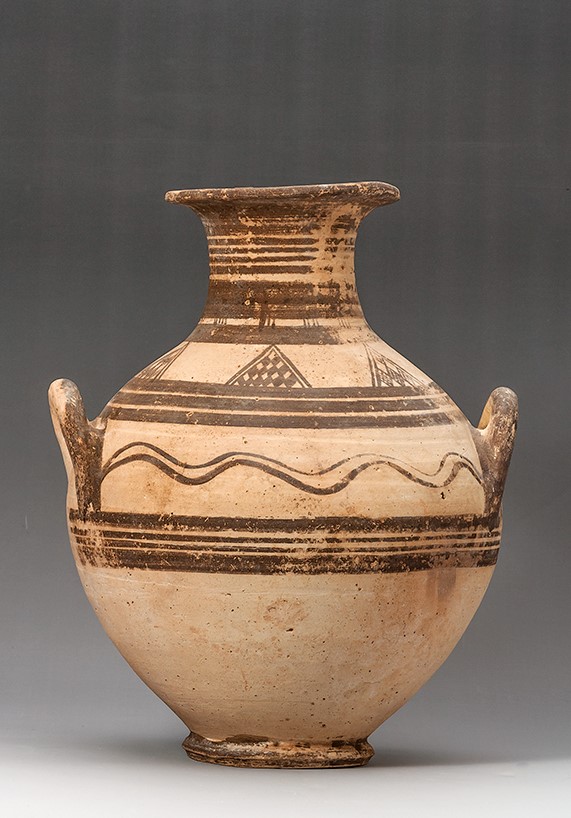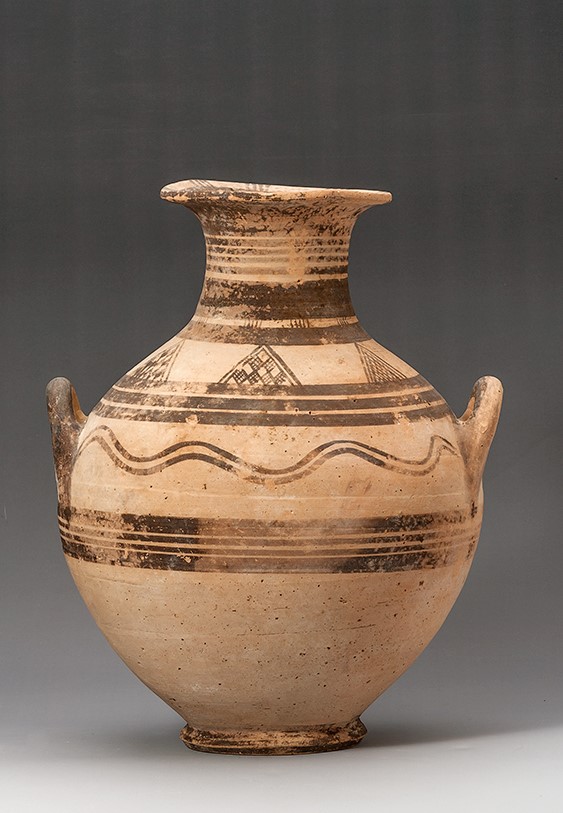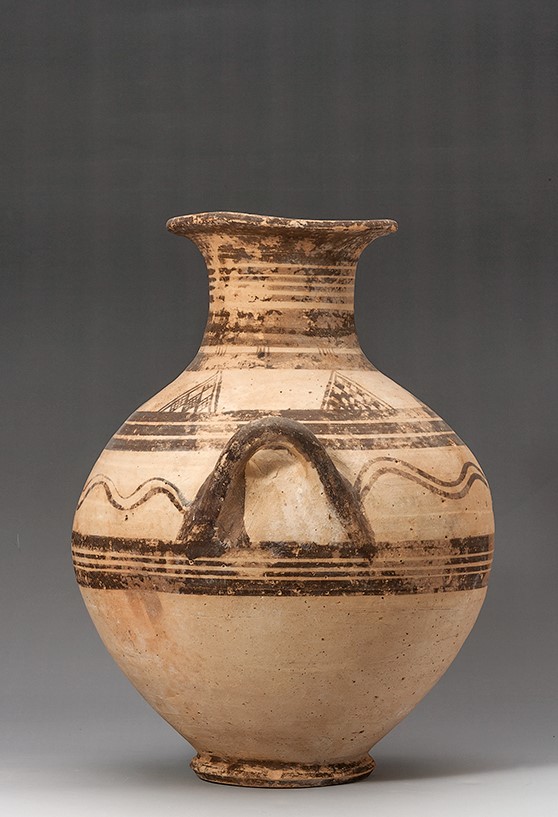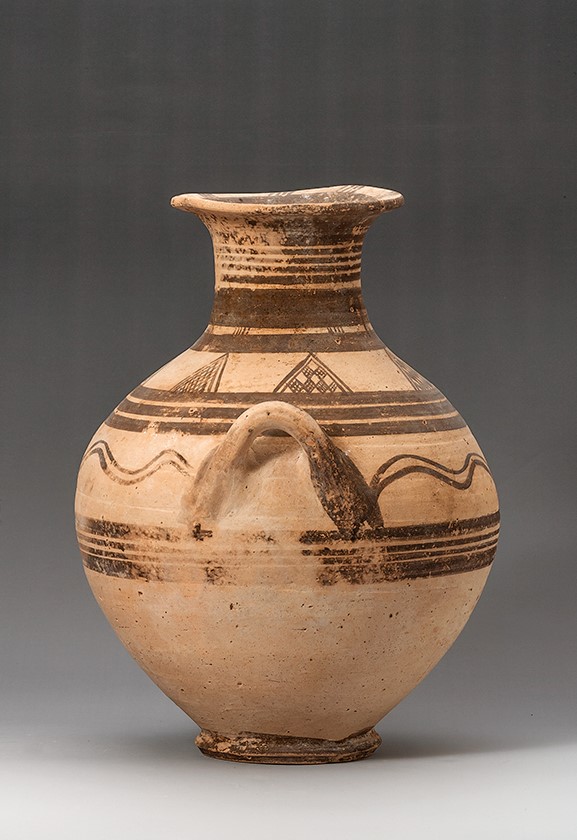Acquisition number: 1981.01
Cypriot Belly-Handled Amphora.
Intact and in good condition. Fairly pale buff clay with fine dark inclusions and with many voids and striations at the surface. Out-turned lip, flattened on the upper face and with a somewhat squared edge; very unevenly finished. Concave neck emerging in a smooth transition from the shoulder. Upright horizontal handles of roughly circular section placed just above the greatest diameter. Ring foot with a pronounced ridge on the outer face, slightly and roughly cut back on the underside.
The decoration is in matt black paint, now worn in places. Within the lip at the top, two bands; on the upper face of the lip, eight groups of four strokes, apparently done with a freehand multiple brush. The neck has broad bands above (extending onto the outer face of the lip) and below, with four lines between. Below that, at the junction with the shoulder, groups of four and five vertical strokes, then another band.
On the shoulder, and bounded below by three bands, a series of six outlined triangles with cross-hatched, cross-hatched lozenges, and solid lozenge fill. Between the handles, a double wavy line. The outer faces of the handles are painted. At the level immediately below the handles, two broad bands with two lines between. The lower body is left plain. The outer face of the foot is painted but the resting surface and the underside are reserved. There is no wash inside the vase.
Title: Belly-Handled Amphora - 1981.01
Acquisition number: 1981.01
Author or editor: J.R. Green
Culture or period: Pre-Classical Cypriot.
Date: Later 11th century BC.
Material: Clay
Object type: Vessels - Amphora
Dimensions: 290mm (w) × 400mm (h)
Origin region or location: Cyprus
Display case or on loan: 1
Keywords: Cypriot, Pre-Classical, Dark Age
Charles Ede Ltd (London), Cypriot Pottery 2300 BC - 475 BC (1980) no. 24 (ill.); J.M. Webb, Cypriote Antiquities in Australian Collections, i (Corpus of Cypriote Antiquities 18, SIMA XX: 18, Jonsered 1997), 46, no. 190, pl. 14; Collection of Classics 11 (wrongly captioned).
1981.01
Belly-Handled Amphora
Purchased. Max. ht ca 40cm; diam. 29cm.
Intact and in good condition. Fairly pale buff clay with fine dark inclusions and with many voids and striations at the surface. Out-turned lip, flattened on the upper face and with a somewhat squared edge; very unevenly finished. Concave neck emerging in a smooth transition from the shoulder. Upright horizontal handles of roughly circular section placed just above the greatest diameter. Ring foot with a pronounced ridge on the outer face, slightly and roughly cut back on the underside.
The decoration is in matt black paint, now worn in places. Within the lip at the top, two bands; on the upper face of the lip, eight groups of four strokes, apparently done with a freehand multiple brush. The neck has broad bands above (extending onto the outer face of the lip) and below, with four lines between. Below that, at the junction with the shoulder, groups of four and five vertical strokes, then another band.
On the shoulder, and bounded below by three bands, a series of six outlined triangles with cross-hatched, cross-hatched lozenges, and solid lozenge fill. Between the handles, a double wavy line. The outer faces of the handles are painted. At the level immediately below the handles, two broad bands with two lines between. The lower body is left plain. The outer face of the foot is painted but the resting surface and the underside are reserved. There is no wash inside the vase.
Compare M. Yon, Salamine de Chypre ii. La Tombe I du XIe siècle av. J.-C. (Paris 1971) pl. 21, nos 62-63; see also the comments and comparisons on p. 33. Perhaps the best available series of amphorae of this type is that from the tombs excavated at Palaipaphos: see V. Karageorghis, Palaepaphos-Skales. An Iron Age Cemetery in Cyprus (Ausgrabungen in Alt-Paphos auf Cypern, 3, Konstanz 1983) tombs 43 (pll. 16-17), 44 (pl. 27), 46, (pl. 43), 49 (pll. 50-51), 50 (pl. 65), etc., together with the drawings at Fig. 37ff., and his notes at 352, Class A.I.iii. The general progression is for the body to become rather squatter from ovoid, and for the neck to become broader. See also B. Kling, Mycenaean IIIC:1b and Related Pottery in Cyprus (Studies in Mediterranean Archaeology 87, Göteborg 1989) 147.
For a study of Protogeometric in Cyprus, see A. Pieridou, Ὁ Πρωτογεωμετρικὁς ῥυθμὸς ἐν Κύπρῳ (Athens 1973), and the article by L. Steele, “Transition from Bronze to Iron at Kourion: A Review of the Tombs from Episkopi-Bamboula and Kaloriziki”, Annual of the British School at Athens (1894/5-) 91, 1996, 287-300.
The shape also exists in Late Helladic IIIC in Greece (e.g. P.A. Mountjoy, Mycenaean Pottery: An Introduction (Oxford 1993) 104 fig. 277; ead., Mycenaean Decorated Pottery (Göteborg 1986) 160-1 fig. 202, with discussion) and continues into Protogeometric and then on into Geometric where it is often the principal item in female graves. The connection between the Greek and the Cypriot versions must have been made during the migrations into Cyprus which occurred in the later 13th and the 12th centuries, and this vase is still similar in form and decoration to what one finds in Attic Protogeometric. After this point, the two series have independent developments.
Eleventh century BC, perhaps the later part.
Charles Ede Ltd (London), Cypriot Pottery 2300 BC - 475 BC (1980) no. 24 (ill.); J.M. Webb, Cypriote Antiquities in Australian Collections, i (Corpus of Cypriote Antiquities 18, SIMA XX: 18, Jonsered 1997), 46, no. 190, pl. 14; Collection of Classics 11 (wrongly captioned).



